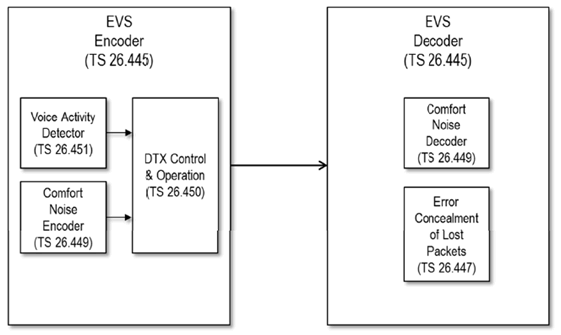TS 26.450
Codec for Enhanced Voice Services (EVS) –
Discontinuous Transmission (DTX)
V18.0.0 (PDF)
2024/03 10 p.
V17.0.0
2022/03 10 p.
V16.0.0
2019/03 10 p.
V15.0.0
2018/06 10 p.
V14.0.0
2017/03 10 p.
V13.0.0
2015/12 10 p.
V12.0.0
2014/09 10 p.
- Rapporteur:
- Dr. Gibbs, Jon
HUAWEI Technologies Japan K.K.
Content for TS 26.450 Word version: 18.0.0
1 Scope p. 5
This document specifies the system level aspects of the Discontinuous Transmission (DTX) function of the EVS codec.
2 References p. 5
The following documents contain provisions which, through reference in this text, constitute provisions of the present document.
- References are either specific (identified by date of publication, edition number, version number, etc.) or non-specific.
- For a specific reference, subsequent revisions do not apply.
- For a non-specific reference, the latest version applies. In the case of a reference to a 3GPP document (including a GSM document), a non-specific reference implicitly refers to the latest version of that document in the same Release as the present document.
[1]
TR 21.905: "Vocabulary for 3GPP Specifications".
[2]
TS 26.445: "Codec for Enhanced Voice Services (EVS); Detailed Algorithmic Description".
[3]
TS 26.442: "Codec for Enhanced Voice Services (EVS); ANSI C code (fixed-point)".
[4]
TS 26.443: "Codec for Enhanced Voice Services (EVS); ANSI C code (floating-point)".
[5]
TS 26.444: "Codec for Enhanced Voice Services (EVS); Test Sequences".
[6]
TS 26.446: "Codec for Enhanced Voice Services (EVS); AMR-WB Backward Compatible Functions".
[7]
TS 26.447: "Codec for Enhanced Voice Services (EVS); Error Concealment of Lost Packets".
[8]
TS 26.448: "Codec for Enhanced Voice Services (EVS); Jitter Buffer Management".
[9]
TS 26.449: "Codec for Enhanced Voice Services (EVS); Comfort Noise Generation (CNG) Aspects".
[10]
TS 26.441: "Codec for Enhanced Voice Services (EVS); General Overview".
[11]
TS 26.451: "Codec for Enhanced Voice Services (EVS); Voice Activity Detection (VAD)".
[12]
TS 26.114: "Multimedia Telephony; Media handling and interaction".
[13]
TS 26.131: "Terminal acoustic characteristics for telephony; Requirements".
[14]
TR 26.952: "Codec for Enhanced Voice Services (EVS); Performance Characterization".
[15]
TS 26.452: "Codec for Enhanced Voice Services (EVS); ANSI C code; Alternative fixed-point using updated basic operators".
3 Abbreviations p. 6
For the purposes of the present document, the abbreviations given in TR 21.905 and the following apply. An abbreviation defined in the present document takes precedence over the definition of the same abbreviation, if any, in TR 21.905.
ACELP
Algebraic Code-Excited Linear Prediction
AMR-WB
Adaptive Multi Rate Wideband (codec)
CNG
Comfort Noise Generator
DTX
Discontinuous Transmission
EVS
Enhanced Voice Services
FB
Fullband
FEC
Frame Erasure Concealment
IP
Internet Protocol
JBM
Jitter Buffer Management
MSB
Most Significant Bit
MTSI
Multimedia Telephony Service for IMS
NB
Narrowband
PS
Packet Switched
PSTN
Public Switched Telephone Network
SAD
Signal Activity Detection
SC-VBR
Source Controlled - Variable Bit Rate
SID
Silence Insertion Descriptor
SWB
Super Wideband
VAD
Voice Activity Detection
WB
Wideband
WMOPS
Weighted Millions of Operations Per Second
4 General p. 6
4.1 Background p. 6
The present document specifies the system level aspects of the Discontinuous Transmission (DTX) function of the EVS codec. Specific codec functions that implement the DTX and other EVS functionalities are described in TS 26.445, TS 26.446, TS 26.447, TS 26.448, TS 26.449 and TS 26.451. The corresponding fixed-point reference C code is specified in TS 26.442 and TS 26.452 using two different sets of basic operators. The corresponding floating-point reference C code is specified in TS 26.443. The EVS test sequences are given in TS 26.444 and the EVS codec is characterized in TR 26.952.
Discontinuous transmission (DTX) is a mechanism for the EVS Codec to encode the input signal at a lower average rate by taking speech inactivity into account. The DTX scheme is useful for the following purposes:
- to conserve UE power,
- to improve network capacity.
4.2 General organization p. 6
The default DTX mechanism described in the present document requires the following functions:
- a Signal Activity Detector (SAD) on the transmit (TX) side;
- evaluation of the background acoustic noise on the transmit (TX) side in order to transmit characteristic parameters to the receive (RX) side;
- generation, on the receive (RX) side, of a similar noise called comfort noise during periods where the transmission is switched off.

5 EVS Codec DTX Operation p. 7
5.1 Transmit (TX) side p. 7
There are two algorithms for extending the DTX hangover period. One is a general hangover algorithm and other is specific to music. Both are defined in clause 5.1.12.5 of TS 26.445.
The main specification of the DTX/CNG algorithms is contained in clause 5.6 of TS 26.445.
The bit allocation of SID frames generated for DTX operation is defined in clause 7.2 of TS 26.445.
5.2 Receive (RX) side p. 7
Operation of the EVS decoder, including decoding of SID frames generated during DTX operation is described in clause 6.7 of TS 26.445.